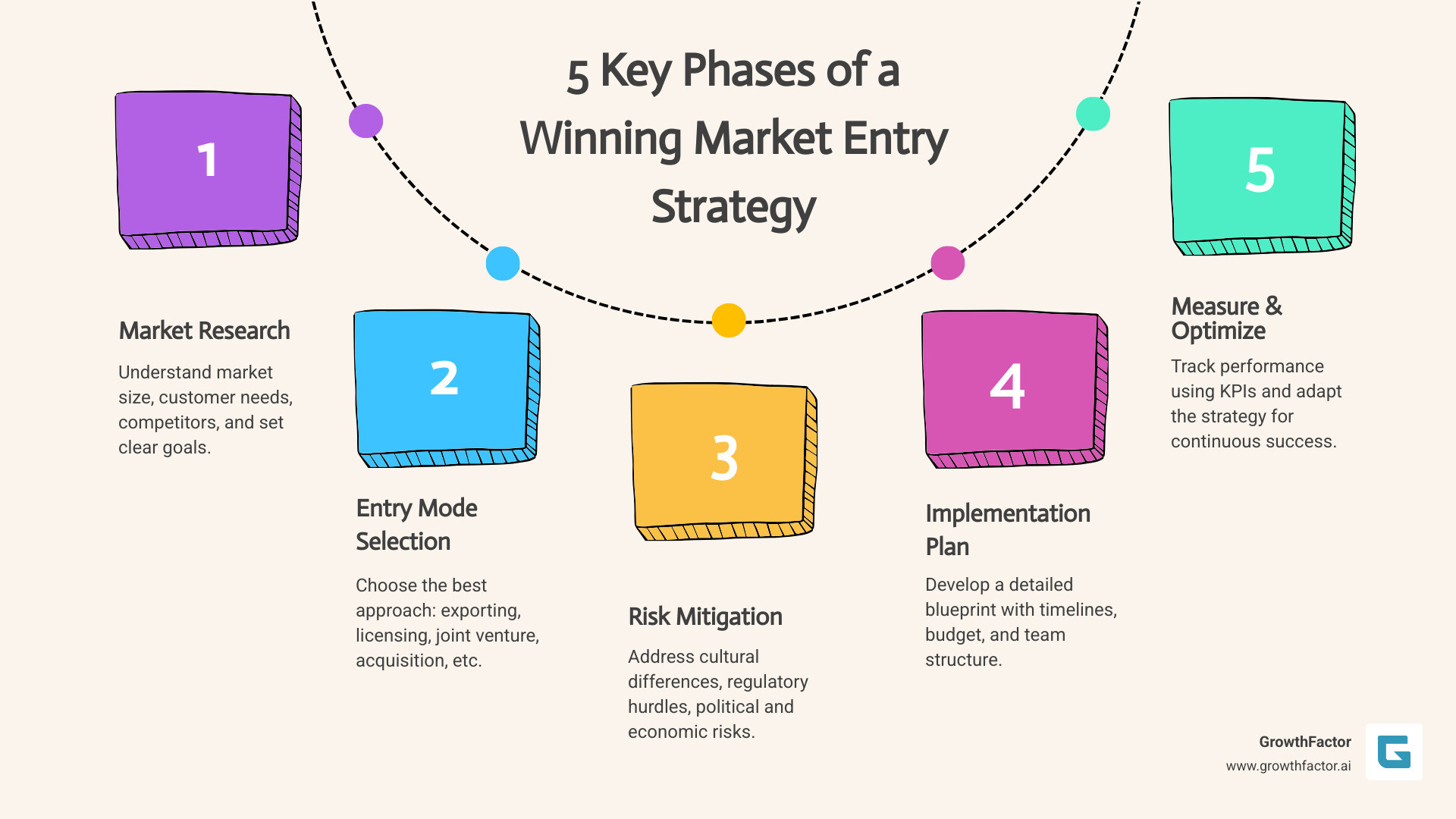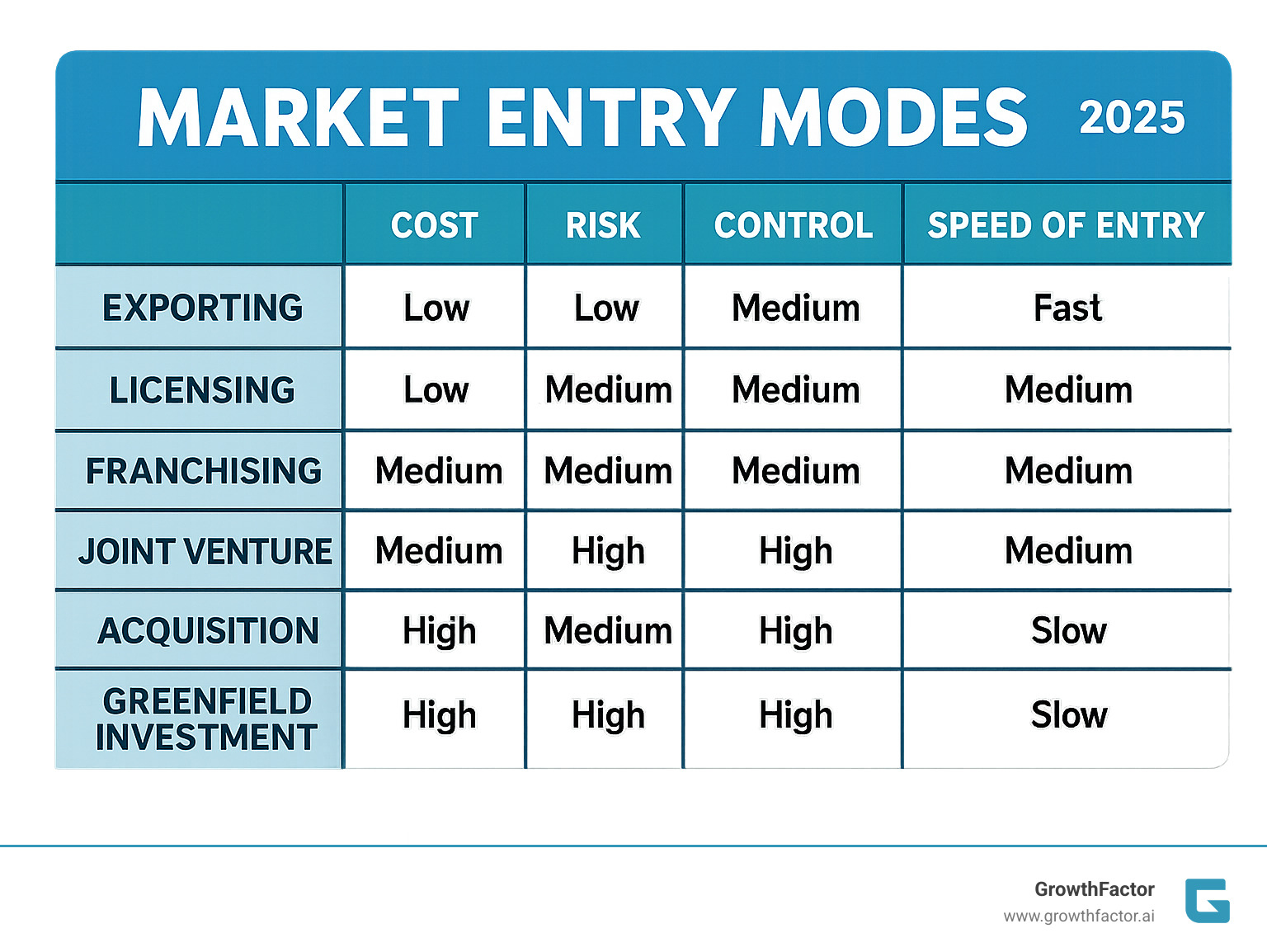The First Step: How to Conquer New Markets with a Solid Strategy
Why Market Entry Strategy Can Make or Break Your Expansion

A market entry strategy is a detailed plan for introducing products or services into a new market. It's a critical blueprint that integrates market research, entry mode selection, risk assessment, financial planning, and performance metrics to steer factors like local culture, competition, and costs.
The stakes are high: research shows that for every successful market entry, roughly four others fall short, and around 65% of startups fail due to premature scaling. However, companies with structured strategies are 33% more likely to hit their revenue goals. Success isn't just about a great product; it's about a solid plan that combines thorough research with smart risk management.
I'm Clyde Christian Anderson, Founder and CEO of GrowthFactor.ai. With a background in retail and investment banking, I've seen how location intelligence transforms expansion success. At GrowthFactor.ai, we've helped retailers evaluate over 2,000 potential locations with 95% forecast accuracy, proving the power of a data-driven market entry strategy.

Market entry strategy helpful reading:
The Core Framework of a Winning Market Entry Strategy
A winning market entry strategy is a living blueprint that guides every decision. It begins with meticulous analysis and follows a cycle of evaluation, selection, and implementation. For retail real estate, our AI-powered platform at GrowthFactor helps streamline Data-Driven Site Selection, enabling efficient and precise evaluation of potential locations.

Phase 1: Comprehensive Market Research and Goal Setting
This phase is the bedrock of any successful expansion. Effective market research answers fundamental questions to reduce guesswork. It involves assessing the market size and growth potential, understanding customer needs and trends, and analyzing the competitive landscape. It's also crucial to investigate the regulatory environment and barriers to entry, along with cultural nuances that impact everything from marketing to business etiquette. Tools like SWOT and PEST analyses provide a holistic view. Our Real Estate Market Analysis AI can significantly accelerate this process for retail real estate.
With this research, you can set clear, measurable goals. Define your strategic purpose, the specific product to introduce, sales targets, timelines, and budget allocations.
Phase 2: Choosing Your Mode of Entry
With research complete and goals set, the next critical decision is how to enter the market. The best approach depends on your goals, resources, and risk appetite.
Here's a breakdown of common market entry strategies:
Direct Exporting: Selling directly to customers in a foreign market.
- Advantages: Fast entry, lower risk and investment.
- Disadvantages: Less control, potential trade barriers.
Licensing: Granting a local business the right to use your intellectual property for a fee.
- Advantages: Leverages local partner's knowledge, lower investment.
- Disadvantages: Less control, risk of IP misuse.
Franchising: Allowing franchisees to operate your business model under your brand name.
- Advantages: Rapid expansion with lower risk, leverages local entrepreneurs.
- Disadvantages: Risk to brand reputation, requires a robust legal framework.
Joint Ventures (JVs): Collaborating with another business to share risks and rewards.
- Advantages: Shared investment, access to local knowledge.
- Disadvantages: Potential for partner conflicts, slower decision-making.
Acquisition: Purchasing an existing business in the target market.
- Advantages: Immediate market presence and customer base.
- Disadvantages: High cost, complex integration.
Greenfield Investments: Building operations from the ground up.
- Advantages: Complete control, customized operations.
- Disadvantages: High cost, high risk, time-consuming.
When choosing an entry mode, consider your goals, resources, market conditions, regulatory complexity, risk tolerance, and desired level of control. For more insights, consult resources like Corporate documents, Chapter 7: Market Entry strategies and explore Global Expansion Retail Strategies.

Phase 3: Mitigating Risks and Navigating Complexities
Entering a new market involves significant risks. Common challenges include cultural misunderstandings, complex legal and regulatory problems (like GDPR), economic and political instability, and intense local competition. Premature scaling without a solid operational base is another major pitfall.

To mitigate these risks:
- Conduct thorough due diligence: Deep research is your first line of defense.
- Form local partnerships: Collaborate with local experts to steer complexities.
- Localize your approach: Adapt products, marketing, and services to local preferences.
- Use a phased rollout: A slower launch allows for testing and adaptation.
- Develop contingency plans: Prepare for scenarios like supply chain disruptions.
- Secure finances and insurance: Ensure adequate working capital and consider export insurance from providers like Export Development Canada to cover credit and political risks.
Financial planning is the backbone of your strategy. It involves detailed cost calculations, securing funding, and creating realistic profitability projections. Both cultural awareness and regulatory compliance are critical; failure in either area can lead to significant financial and reputational damage.
From Blueprint to Reality: Implementation and Measurement
Having a strategy document is like having a map; implementation is the actual journey. This phase requires the right team, clear timelines, and a solid budget. From day one, tracking systems are essential to ensure you're heading in the right direction and can course-correct as needed. For retail businesses, this is especially true for site selection, where understanding How to Choose Retail Location is paramount.
Building the Blueprint: Creating Your Market Entry Strategy Document
A formal strategy document is your North Star, essential for securing financing and aligning your team. It should tell a complete story, starting with an executive summary and mission statement. The core of the document includes a situation analysis (with a SWOT analysis), a detailed target market profile, and a marketing and sales plan outlining your chosen entry modes. Crucially, it must contain realistic financial projections—including budgets, sales forecasts, and profitability analysis—and conclude with actionable steps and timelines.
Measuring Success: KPIs for Your Market Entry Strategy
Launching is just the beginning. To measure performance, track a mix of key performance indicators (KPIs).
- Market & Brand Metrics: Track market share to see how much of the pie you're capturing and brand recognition to measure awareness.
- Customer Metrics: Monitor Customer Acquisition Cost (CAC) and Customer Lifetime Value (CLTV) to ensure your growth is sustainable.
- Financial Metrics: Return on Investment (ROI) provides the bottom-line view of profitability, while sales volume and revenue are direct measures of success.
- Digital Performance: Website traffic and conversion rates from the new market offer early indicators of traction.
Numbers only tell part of the story. Qualitative feedback from surveys, focus groups, and customer reviews provides the "why" behind the data, offering invaluable insights for refinement. Businesses that commit to this continuous monitoring are 33% more likely to achieve their revenue goals.
Conclusion: Your Next Step Toward Market Conquest
A winning market entry strategy requires careful planning, deep market understanding, and the flexibility to adapt. The journey moves from research and goal setting to choosing an entry mode, managing risks, and finally, implementing and measuring your plan.
Technology has revolutionized this process. At GrowthFactor, our AI-improved platform with AI Agent Waldo is designed for retail real estate professionals. We help teams evaluate five times more sites with greater efficiency, automating the qualification process that once took weeks. This allows for faster, data-driven decisions and more successful expansions.
We offer flexible plans (Core at $500, Growth at $1,500, and Enterprise options) and are based in Boston and Cambridge, Massachusetts.
Ready to turn your expansion plans into a success story? Explore solutions for retail brands and see how our technology can transform your market entry strategy.
Citations
The human algorithm
Ready to see what we're cooking?
Submit your information below and we'll be in touch to schedule.







